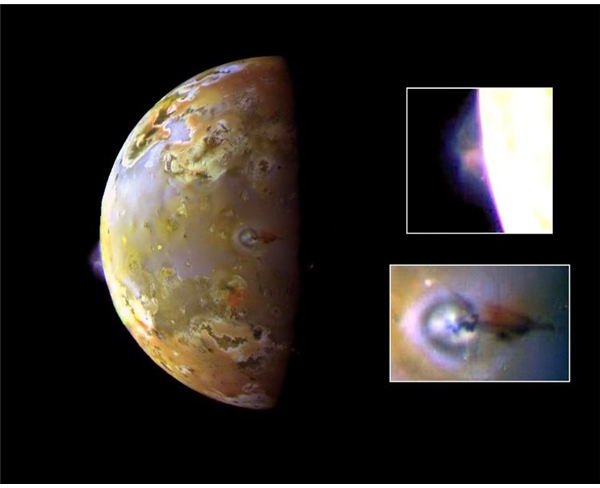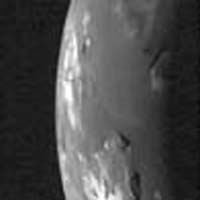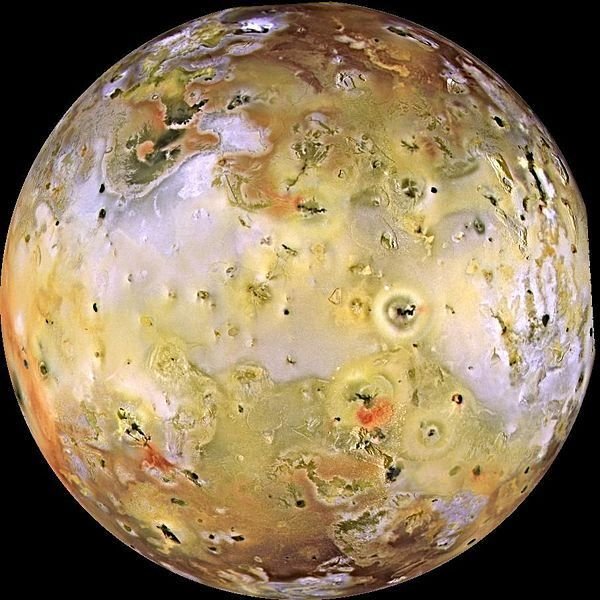Io Jupiter's Moon: Learn Important Facts About Io - One of the Many Moons of Jupiter
Images of Io
Important Facts About Io, Jupiter’s Moon
1) Year discovered: 1610
2) Discovered by: Galileo Galilei
3) Position among Jupiter’s moons: 5th moon from the planet
4) Size among Jupiter’s moons: 3rd largest
5) Closest distance to Jupiter: Periapsis: 420,000 km, 260,976 miles
6) Furthest distance from Jupiter: Apoapsis: 423,400 km, 263,089 miles
7) Mean orbit radius: 421,700 km, 262,032 miles
8) Rotation: synchronous with Jupiter (9hr 55m 30s)
9) Orbital period: 42hr 27m 33.5s
10) Orbital Inclination to Jupiter’s equator: 0.05 degrees
11) Eccentricity: 0.0041
12) Diameter (equatorial): 3,643 km, 2,264 miles
13) Mass: 8.9319x10^22 kg, 14.1.9691x10^23 lbs
14) Gravity: .183 (Earth = 1)
15) Escape Velocity: 2.558 km/s, 1.589 miles/s
16) Surface temperature (mean and max): -143C to -73C, -225.4F to -99.4F
17) Surface pressure: trace
18) Atmospheric composition: sulfur dioxide.
19) Albedo: 0.63
Fascinating Io Facts
1) The most volcanically active body in the solar system. With more than 400 active volcanoes, Io doesn’t have the cratered surface common to so many other moons: powerful lava flows continually reshape the landscape. The Ionian volcano Loki, believed to be the solar system’s most powerful volcano, can spew out up to 1,000 square meters of lava each second.
2) Planetary tides of 100 meters (330 feet). Those are tides pushing and pulling the rocky surface (for comparison’s sake, Earth’s ocean tides vary by no more than 18 meters or 60 feet). The tidal forces are exerted in combination by Jupiter and two of its other large moons, Europa and Ganymede. It’s the energy generated by these tides, rather than internal heat, that powers Io’s geologic activity.
3) Hottest temperatures outside the sun. While the mean surface temperature of Io is quite frosty (-143C or -225.4F), things get hot near active volcanoes. Hot spots discovered by the Galileo spacecraft showed temperatures of up to 1,610C (2,910F).
4) Tallest mountains in the solar system. Io’s active geology builds not only supervolcanoes but super-size mountains up to 16,764 meters (55,000 feet) tall. That’s a far higher climb than the one up Earth’s Mt. Everest, which stands a mere 8,848 meters (29,029 feet) tall.
5) Strange ingredients in the atmosphere. Io’s very thin atmosphere is mostly sulfur dioxide, but the moon’s volcanism helps pump out trace amounts of silicon monoxide, silicon dioxide, iron monoxide and even gaseous salt, potassium and iron.
Io’s Volcanic Plumes and Loki


Credits:
https://solarsystem.nasa.gov/planets/profile.cfm?Object=Jup_Io
https://www.daviddarling.info/encyclopedia/I/Io.html
https://en.wikipedia.org/wiki/Io_(moon)#cite_note-Thomas1998-0
https://www.eurekalert.org/pub_releases/1998-01/UoW-HFOM-090198.php
https://www.eurekalert.org/pub_releases/2003-01/jhu-voj123002.php
https://www.eurekalert.org/pub_releases/2001-02/WUiS-Scft-2502101.php
